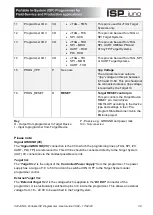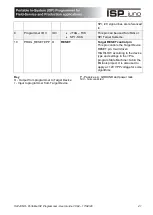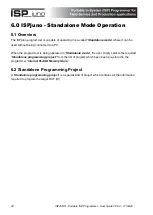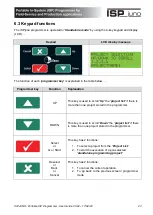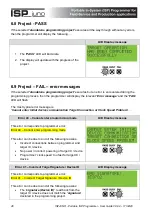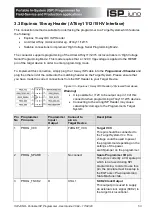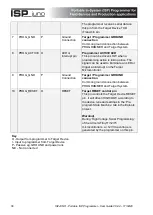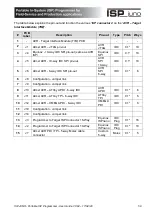
ISPJUNO - Portable ISP Programmer - User Guide V0.84 – 17/04/20
53
3.3 Equinox 10-way Header (ATtiny11/12/15 HV Interface)
This connection method is suitable for interfacing the programmer to a Target System which features
the following:
•
Equinox 10-way IDC ISP Header
•
An Atmel ATtiny microcontroller eg. ATtiny11/12/15
•
Suitable connections to implement ‘High Voltage Serial Programming Mode’.
The connector supports programming of the Atmel ATtiny11/12/15 microcontrollers in ‘High Voltage
Serial Programming Mode’. This mode requires that a +12.0V Vpp voltage is applied to the RESET
pin of the target device in order to enter programming mode.
To implement this connection, simply plug the 10-way ISP cable into the
Programmer J6 header
and
plug the other end of the cable into the matching header on the Target System. Please ensure that
you have made the correct connections from the ISP Header to your Target Device.
Figure 3.3 – Equinox 10-way IDC Header (J8) viewed from above
Warning!
•
It is possible for +12V to be output on pin 10 of this
connector when programming ATtiny11/12/15 devices.
•
Connecting to the wrong ISP Header may cause
catastrophic damage to the Programmer & Target
System
Pin
No
Programmer
Pin name
Programmer
Input /
Output
Connect to
pin on
Target Device
Description
1
PROG_VCC
P
TARGET_VCC
Target VCC
This pin should be connected to
the Target System Vcc. This
voltage could be used to power
the programmer depending on the
settings of the power
switch/jumper on the programmer.
2
PROG_SPARE
-
No connect
Spare Programmer I/O pin
This pin is currently a I/O spare pin
which is not used during SPI
programming. In order to use this
pin, the pin state must be setup in
the EQTools <Pre-programming
State Machine> tab.
3
PROG_TSCK2
O
XTAL1
SCK2 Clock Output
This output pin is used to supply
an external clock signal (SCK2) to
the target microcontroller.

